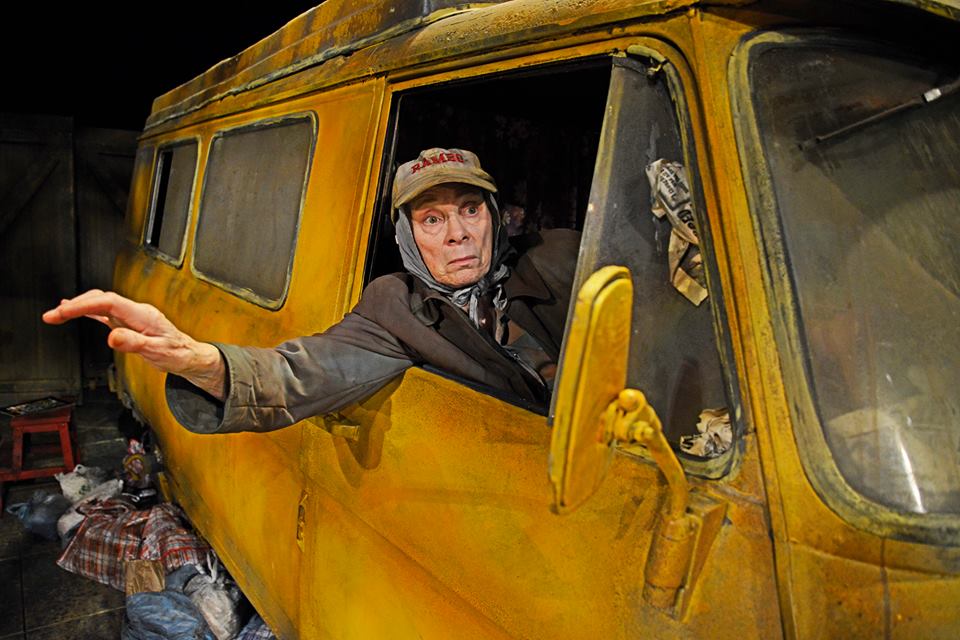
It is almost twenty years since Alan Bennett immortalised Miss Shepherd, she of the now famous dilapidated yellow van, parked in his front garden near Primrose Hill. Fifteen years is how long she remained on his patch. If nothing else, the story of The Lady In The Van exposes the rich, if slightly detached, seam of compassion running through Bennett’s persona. Unlike his supposedly socialist but NIMBY neighbours, by offering a safe haven to a vagrant, he comes out of this as positively saint-like.
As to be expected from the pen of Bennett, the high points in the play are much more to do with turn of phrase and observation rather than anything particularly dramatic, with the exception of the enactment of an extraordinary ‘Ascension’ near the conclusion. A reference to Miss Shepherd’s ‘odoriferous concerto’, a reference to her pungent aura of lavender talc, damp and excretions, was one such livid moment.
Bennett cleverly engages two versions of himself throughout the play. His writing and gentle wit is never stronger than when exploring inner arguments and discourses with himself. Sam Alexander and James Northcote provide an effective double act, identically bedecked in red cardies and tweed jackets, speaking in that Yorkshire-tinged, kindly, mischievously ironic way that is Bennett’s signature.
I have not seen the film, so I did not have Maggie Smith’s version of Miss Shepherd in mind when seeing the play. Sara Kestelman brought the role palpable belligerence, but also convinced with a performance that exposed Shepherd’s vulnerability and potpourri of delusions – where God and the Highway Code seemed to collide – with just enough nouse to hold off officialdom, but at a loss as to her toilet.
Bennett’s ailing ‘Mam’ makes an appearance, a very well observed cameo played by Gabrielle Lloyd. Bachelor Bennett bemoans the fact that he now has two old ladies making demands upon him, but at the same time sees a chance to comment, with gentle irony, on how the two women differ in their raging ‘against the dying of the light’. With the intrusion of the eccentric Shepherd, he is even moved to examine the quality of his own life experience against that of the itinerant outside the window.
The Lady In The Van gives Bennett the opportunity to paint portraits of his immediate North London neighbours and their reactions to Shepherd’s ‘invasion’. Paul Hickey as Rufus, and Emma Amos as his wife Pauline, portray the superficially ‘concerned’ residents who are more concerned about their property values as Shepherd’s van slowly advances along the street towards them. In a memorable line, Bennett exposes Rufus’s white middle-class stand-offish coping mechanism with the line “By unfeeling we are saved.”
There are other good cameos. William Gaunt, in particular, was an impressive ‘Underwood’, the enigmatic old man who suddenly appears and seems to know more about Miss Shepherd’s past. And Cat Simmons nailed it as the social worker translating Bennett’s frustration with Shepherd’s situation as his own latent aggression.
Jonathan Church’s direction had more going for it in the second half when a doctor, social worker and the introduction of Underwood interrupted what could have been a repetitive series of Shepherd-Bennett face-offs. Robert Innes Hopkins’ lovingly realised set with some subtle and effective lighting by Tim Mitchell was always a good backdrop to the action, with the mimosa yellow Commer van and the Reliant Robin enjoying grand stage entrances and exits. Shepherd’s religious pleadings, delivered from inside the van, with its back doors wide open, was reminiscent of a shrine with gates ajar.
The question The Lady In The Van poses is ‘what would we do if faced with Bennett’s dilemma?’ Despite the unquestionable inconvenience that Shepherd surely was, Bennett, in the end, I suspect, rather admired her tenacity and eccentricity, saw the precariousness of her situation and took her in. Perhaps, in the end, in some ways she mirrored his own, rather solitary path. ★★★☆☆ Simon Bishop 23rd August 2017
Photos by Nobby Clark

